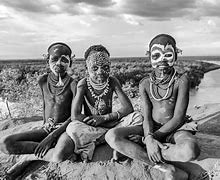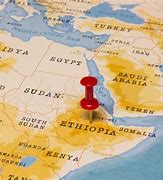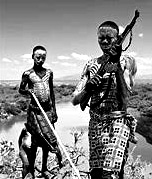
I have always stated that every belief, whatever it may be, is respectable. Of course, as long as it does not threaten the lives of others, or their fundamental rights, especially if these rights protect the little ones.
Children “mingi” They are children, children of superstition, condemned to death for being born to a single mother, suffering from malformations or having their upper teeth emerge first. and many other questions that the elderly always tend to decide. The previous words about “mingi”, I read them in an article in the newspaper La Verdad, in August 2013. And they impacted me.
The Karo are an ethnic group (tribe) established in an area of the Omo River, in Ethiopia, in a place known as the Southern Nations. This tribe lives in a privileged natural environment, they are sedentary, although they graze the few cattle they have. They fish for large catfish such as sirulos, grow millet and collect honey. The children are decorated with flowers, while the women prepare their daily chores and the elderly paint strange ritual symbols. For a tourist, who when he arrives is welcomed with open arms, that place is like paradise, although without electricity or running water, but nothing could be further from reality.
Until 2012, apparently, when night fell and they stopped counting the moons, observing the termite mounds and delighting in the acacias that populated the savannah, according to Mamush Eshetu, a young 43-year-old tour guide, who could not find the peculiar beliefs of that not at all positive tribe, he confessed to whoever would listen that Until recently they threw their children into the river, sacrificed them.

Until then, no one outside the few villages of the Karo ethnic group had demonstrated against the power of the elders to decide on the life and death of the people. “mingi”. These were children considered cursed upon whom the decision to be killed fell, no matter what the parents might say. Why were certain children considered cursed? Why were they condemned?
The traditions in that part of the planet, in the heart of Africa, remain a mystery and only by telling and retelling these stories can we scratch the surface of their beliefs, which, spread throughout the world as a result of the slave trade in times past, give us back stories of child sacrifice almost everywhere these kinds of ideas landed.
But returning to the cursed children of the Omo Valley, they were murdered for the most diverse reasons: for being born out of wedlock, because the parents had not communicated to the chief of the tribe that they wanted to have a child, because the child at birth suffered from some kind of illness. malformation, no matter how small it was, because the baby’s upper teeth came out in the first place, because there were twins… And so on, a long etcetera of contingencies that were left to the discretion of the witches, who, with the excuse that the bosses The tribe did not like cursed children, due to the superstition that if they became adults they could harm the tribe, bring bad luck. And that argument, in a place where famines and drought are continuous and constant, is incontestable.
Only the denunciations of some members of the Karo ethnic group, such as Lale Lakubo, have managed to modify customs, or at least make visible worldwide an atrocious tradition anchored in powerful beliefs as old as the tribe itself.
International cooperation or the protests of a corrupt government that receives funds to stop these practices and educate in human rights are of no use when it is so easy, due to superstition, to take the life of a child. The crocodiles of the Omo River, or the hyenas of the desert make sure that no trace of such a cruel practice remains.

Boys or girls are literally torn from the clutches of their parents without their parents being able to do anything for them. And if it began by collecting the words of a modest chronicle from the aforementioned newspaper, allow it to continue 10 years later, in March 2023, with the newspaper El País where, the aforementioned member of the Karo ethnic group, declared the following: “One day I was in my village and I saw an argument near the river. There were about five or six people fighting with a woman who was carrying a very small child. The boy and her mother cried while the others struggled with her. They managed to snatch her son from her and ran towards the river. “They threw the child into the water before she could do anything.” When these events occurred, Lale Lakubo was a teenager and felt scandalized, until his mother told him that two of his sisters, as children, were also murdered because the elders of the tribe considered them to be “mingis”, damn
Lale himself gives an approximate number of children murdered each year within this community for being “mingis”, around 300. Children to whom absolutely nothing happens, except living in a place where life and death are decided by a terrible balance hidden in the twisted hearts of the elders of the tribe, rooted in ancient and perverse ideas. It is as if the Karo ethnic group is still in an ancient era where the gods continue to demand blood rituals.
Some anthropologists place the beginning of these practices at the end of the last century, but this question is, honestly, according to other researchers, implausible, because this practice is related to famines and droughts, which have been devastating that area of the earth for some time. many decades. Furthermore, it is not only in this area of Ethiopia where some children are declared cursed. In my next article related to impossible beliefs, I will talk about the witch children of Nakayi. And later on albino children In short, atrocious beliefs that some people try to alleviate as best they can.
After living the experiences he had and seeking some small support, Lale Lakubo, now over 40 years old, started an orphanage school a few years ago in the nearby city of Jinka, called Omo Child, which welcomes currently around 50 children and adolescents between 2 and 19 years old. All of them declared “mingi”. Lale, after arduous conversations with the elders of the tribe, managed to get them to give him some of the children who were going to be sacrificed. He feels that he cannot help everyone, but it is like an island of peace in the midst of so much superstitious desolation. Their project is maintained thanks to the private donations of people who try to alleviate this tragedy, some of the parents of these children also collaborate and the meager fees of other children and adolescents who go to study at the school that takes place in the facilities. The fact is that the project, little by little, is growing slowly but in an increasingly visible way.
In 2015, produced and directed by John Rowe, with Tyler Rowe as director of photography and Matt Skow as editor, a documentary titled Omo Child: The River and The Busch. Based on the exciting journey of Lale Lakubo and the mingi, where you can follow the trajectory of this man, as well as what happens with the Karo ethnic group, and other people of the ethnic groups Hamer and Bannar, with whom they share unfortunate beliefs.
Miherit Belay, head of the Ministry of Health, Women, Children and Youth in the Omo Valley area, currently states: “We receive new cases every month, but most are never known. It is something that the villages keep secret. It must be taken into account that here families live in a very large space, sometimes separated by 50 or 60 kilometers, in areas that are difficult to access and without coverage, where it is very difficult to find out about things like a pregnancy and even less about something like a sacrifice.”
All these stories do not reach the media, except sporadically. They are not interested. Who is interested in Ethiopia? They are places where people die every day of hunger, where there is not the slightest possibility of getting ahead in the way we know it. Imagine then, as Miherit Belay says, how difficult it is for them to know if sacrifices occur.
Bibliography:
https://elpais.com/planeta-futuro/2023-03-01/un-refugio-para-los-ninos-malditos-de-etiopia.html#
La Verdad Newspaper, 08/11/2013. Page 40
https://vimeo.com/116630642 (In this link you can see the trailer of the aforementioned documentary about Lalo and the “mingi”)
Originally published at LaDamadeElche.com









